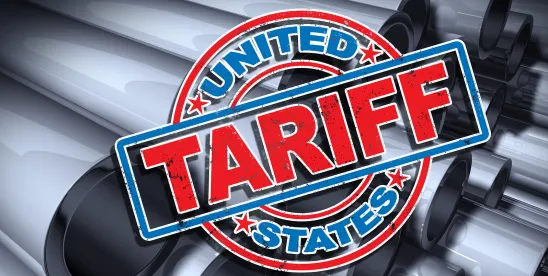What Has President Trump Announced?
On February 10, 2025, President Trump signed proclamations titled Adjusting Imports of Steel Into the United States and Adjusting Imports of Aluminum into the United States. The proclamations cover both steel and aluminum tariffs, which will be raised to a flat 25%. In particular, the steel and aluminum proclamations establish the following tariff principles:
- The Section 232 aluminum tariffs, which the Trump administration imposed in his first administration, are raised from 10 percent to 25 percent.
- The Section 232 steel tariffs, which already were set at 25 percent but which contained significant carveouts for most major sources of steel products, including steel from Brazil, Canada, and South Korea, will be implemented “without exceptions or exemptions.”
- All product-specific exemptions that had been granted under the prior Section 232 tariffs are eliminated.
- The steel and aluminum proclamations apply not only to products previously identified in Proclamation 9705 (2018) and Proclamation 9980 (2020) but also to additional derivative steel products and derivative aluminum products to be identified in forthcoming annexes to the proclamations.
- The United States will set up a process to allow U.S. industry groups and U.S. producers of steel and aluminum to request that other derivative products be added to the annexes.
- The steel and aluminum proclamations include exemptions only for derivative steel products “melted and poured” in the United States and derivative aluminum products “smelted and cast” in the United States, to curb imports of minimally processed metals from other countries that circumvent the prior tariffs. In other words, derivative products that are produced from steel and aluminum that originated in the United States, which then were processed abroad into a derivative product, would be exempt from the new 25 percent tariffs.
The full impact of these tariffs will take time to work through the market. Nonetheless, the announcements sent major shock waves through the manufacturing community. To help companies sort out the potential impact of these new tariffs, this article works through the top-of-mind questions for most major aluminum and steel importers. It then provides some strategies for companies looking to manage tariff-related risks, including by buttressing supply chains and building in contractual flexibility.
Our expectation is that these are the opening salvos in a likely international trade war, not the last shot. Notably, after the issuance of the steel and aluminum proclamations, a White House official confirmed these tariffs would “stack” on any other tariffs. For example, if the currently suspended 25% increase in tariffs for Canada and Mexico are implemented, then imports of Canadian and Mexican aluminum and steel would face new 50% tariffs.
What Are the Key Open Questions and Ambiguities in the Announcement?
- What products are covered? The coverage of the presidential proclamation is broad, covering all basic forms of steel and aluminum. In addition to steel and aluminum products subject to previous Section 232 duties, the proclamations will include forthcoming annexes incorporating further derivative steel and aluminum products.
- How far downstream does the proclamation extend? The coverage likely extends to numerous downstream products such as pipes, tubes, and aluminum extrusions. The full list of derivative products covered by the proclamations will be listed in yet-to-be-published annexes.
How does this interact with the prior Section 232 duties imposed in President Trump’s first term? The effect of the steel and aluminum proclamations is basically to replace the prior Section 232 duties — including all their exemptions and negotiated alternative quota arrangements — with new, uniform duties under the current proclamations, including to a potentially larger set of products to be covered in the forthcoming annexes. This has the effect of both broadening the scope of the prior duties and also extending them to countries that had negotiated alternative measures to the prior Section 232 tariffs, such as by imposing quotas for exports of steel and aluminum to the United States in exchange for having the tariffs dropped. The proclamations also eliminate all the product-specific exemptions granted under both the prior Trump and Biden administrations. Thus, the proclamations represent a level-setting of the prior Section 232 tariffs, bringing everything to a uniform 25% rate for all countries and for all products.
- What about the Section 301 duties? The Section 301 duties applicable to Chinese-origin products remain fully in place. Because those tariffs (recently increased by an additional 10%) cover basically all imports from China, including aluminum and steel products, the new aluminum and steel tariffs ladder on top of the Section 301 duties. Thus, there can be duties as high as 60% for Chinese aluminum and steel, in addition to the normal Chapter 1–97 tariffs, of the Harmonized Tariff Schedule of the United States (HTSUS) that generally apply to imports from all countries.
- What about all the antidumping and countervailing duty orders on various steel and aluminum products? In addition to Section 232, Section 301, and standard Chapter 1–97 duties, in situations where there are antidumping or countervailing duty orders on steel or aluminum products, these duties also would be added on. Because antidumping and countervailing duty orders are placed on products from a particular country or countries, the analysis of whether such additional duties are due for steel and aluminum imports would depend on the country at issue, as well as whether the product being imported falls within the written scope of the antidumping and countervailing duty orders. But because of the large number of antidumping and countervailing duty orders, an appreciable number of products will be covered by these tariffs as well. It accordingly is essential for steel and aluminum importers to be carefully scrutinizing the potential applicability of such orders to their steel and aluminum products.
- Would the USMCA allow us to avoid these duties by importing first into Canada or Mexico? Merely transshipping products through a third country, such as Canada or Mexico, does not alter the tariffs to be paid on that product if it eventually comes into the U.S. customs territory. Further, the steel and aluminum proclamations impose a new U.S. melt-and-pour requirement for steel and a smelting requirement for aluminum in order to claim an exemption from the Section 232 tariffs.
- Can we avoid the tariffs by doing a moderate amount of processing before importing the steel and aluminum? This would depend on whether the processing is sufficient to take the product out of the HTS classifications listed in the forthcoming annexes of derivative steel/aluminum products.
- Are the trade courts likely to strike this measure down? The imposition under Section 232 of aluminum and steel tariffs in the first Trump administration was appealed to both the Court of International Trade and the Court of Appeals for the Federal Circuit. The end result was that the prior use of Section 232 to invoke national security grounds to impose tariffs to protect the U.S. aluminum and steel industries was upheld. While a challenge to the new proclamations is likely, these precedents will make it difficult for such a challenge to succeed.
- Don’t these special tariffs violate the WTO Agreements? WTO agreements will not provide relief from these tariffs for steel and aluminum importers. Several countries have already brought a WTO challenge or indicated that they will be doing so soon. But the WTO’s dispute resolution process has been effectively brought to a standstill in recent years, as multiple U.S. administrations have blocked appointments of panelists to the WTO’s Appellate Body, which is the final stage of any dispute resolution. Also, WTO dispute resolution takes years to finish.
- Will major importing countries negotiate a resolution to these tariffs? It is likely that they will try. Australia already has indicated it will seek to negotiate an alternative to the imposition of the tariffs. Australia is viewed as being better positioned than most countries for such a resolution because it maintains a trade deficit with the United States, whereas other major steel and aluminum exporters to the United States have trade surpluses. That said, it would not make sense to eliminate the prior settlements through the new imposition of aluminum and steel tariffs if the end goal were to put something similar back in place. Because the U.S. aluminum and steel industries were viewed as having their relief undermined by prior negotiated alternative provisions, as well as the grant of hundreds of product-specific exemptions, it is expected that negotiated alternatives to the tariffs will be much more difficult to achieve this time around.
- How will we get clarity regarding the scope of these new tariffs? The new Section 232 tariffs are to go into effect on March 12, 2025. Additional information — including the publication of the annexes — will need to be provided so these tariffs can be applied. We expect that the publication of the proclamations in the Federal Register will provide at least some further clarification as to the scope of the measures — including the annexes — as well as subsequent guidance from U.S. Customs & Border Protection.
- Are there any other trade- or tariff-related measures we need to be monitoring? Yes. Speaking from the Oval Office, President Trump said the steel and aluminum tariffs were “the first of many” to come. In particular, he said his international trade team would be meeting over the next four weeks to discuss potential new tariffs on cars, chips, pharmaceuticals, and other goods. He already has imposed 10-percent tariffs on Chinese-origin imports (on top of the existing Section 301 duties from the first Trump administration, which apply to around half of all goods imported from China and impose tariffs up to 25 percent). He has threatened tariffs of up to 25 percent on all goods from Canada and Mexico, which are currently suspended for 30 days to give negotiators time to work out an agreement to address unauthorized immigration and illegal trafficking in fentanyl and other drugs. And he has threatened reciprocal tariffs, which would raise U.S. tariff rates on any products from countries that impose higher tariffs on the same goods when exported from the United States. Finally, he also has vowed to raise U.S. tariffs still further on any country that retaliates against the U.S. tariffs.
What Should Our Company Do to Cope With These Potentially Costly New Duties?
- Gather information on importing patterns to determine tariff-related vulnerability. Importers should gather information regarding their steel and aluminum products, and their importing patterns related to those products, to pinpoint tariff-related risks and vulnerabilities. Supply chain mapping, the process of documenting all suppliers and the flow of goods and products in a supply network, can be an important tool for importers looking to gain proper insight into their network. A clear picture of one’s supply chain allows importers to identify tariff-saving opportunities and to proactively address pressure-points creating vulnerabilities.
- Gather contracts and determine tariff-related flexibility. Global trade dynamics necessitate flexible supply chain contracts for both suppliers and purchasers. The starting point is to identify goods facing high tariff rates and to gather all of your supply- and sell-side contracts and determine how they handle tariff-related risks for these goods. In general, when it comes to tariff-related risks, these contracts generally fall into two buckets: (1) ones that contain no provision relating to tariffs or that contain pricing-related provisions, which may indirectly allocate risks relating to tariffs but not provide any real flexibility to deal with unexpected tariff changes; and (2) ones that include clear tariff-related provisions. To the extent possible, in any situation where your company bears tariff-related risks (generally, where your company has agreed to act as the importer of record), you want to be in the posture of moving contracts toward the second scenario.
- Look for ways to update supply-side contracts for supply chain flexibility and sharing of risk. Fixed-price contracts typically assign cost risk to the seller. If tariffs increase costs, suppliers cannot unilaterally demand price adjustments unless the contract allows for cost-sharing mechanisms. An example of price adjustment protection language would be as follows: Supplier reserves the right to adjust prices to reflect the impact of any tariffs, duties, or similar governmental charges imposed after the date of this proposal. These adjustments will be calculated to ensure fair allocation of the increased costs. Supplier will provide advance notice of any such adjustments along with documentation supporting the changes.
- Look for ways to update sell-side contracts for allowing surcharges and pricing flexibility. Sellers wanting to protect themselves and to have added flexibility should seek to include price adjustment rights in their contracts. Some contracts tie prices to commodity indexes, mitigating the impact of sudden market changes. If a supplier anticipates tariff risks, an indexed pricing structure may provide some protection.
- Incorporate procedures to regularly review new contracts and contracts coming up for renewal to incorporate tariff flexibility and tariff-sharing provisions. Regularly reviewing new contracts and contracts up for renewal allows companies the opportunity to amend their standard terms and conditions and to incorporate provisions that can lead to more flexibility and an equal tariff-sharing burden. An example of contract language to create flexibility in a tariff-changing environment would be: If new tariffs, duties, or similar government-imposed charges are introduced after contract execution, the parties will renegotiate pricing in good faith to reflect the impact of such charges.
- Look for ways to create commercial leverage to share tariff-related risks. The imposition of additional tariffs can be just as devastating for sellers as it is for buyers. Look for contractual leverage points relating to contract renewals or potential expansion of purchasing patterns. Consider moving up contract renewals to combine term extensions with tariff-related risk sharing. By proactively addressing these issues in supply chain agreements, businesses can better navigate economic volatility while maintaining contractual clarity and financial stability.








 />i
/>i

